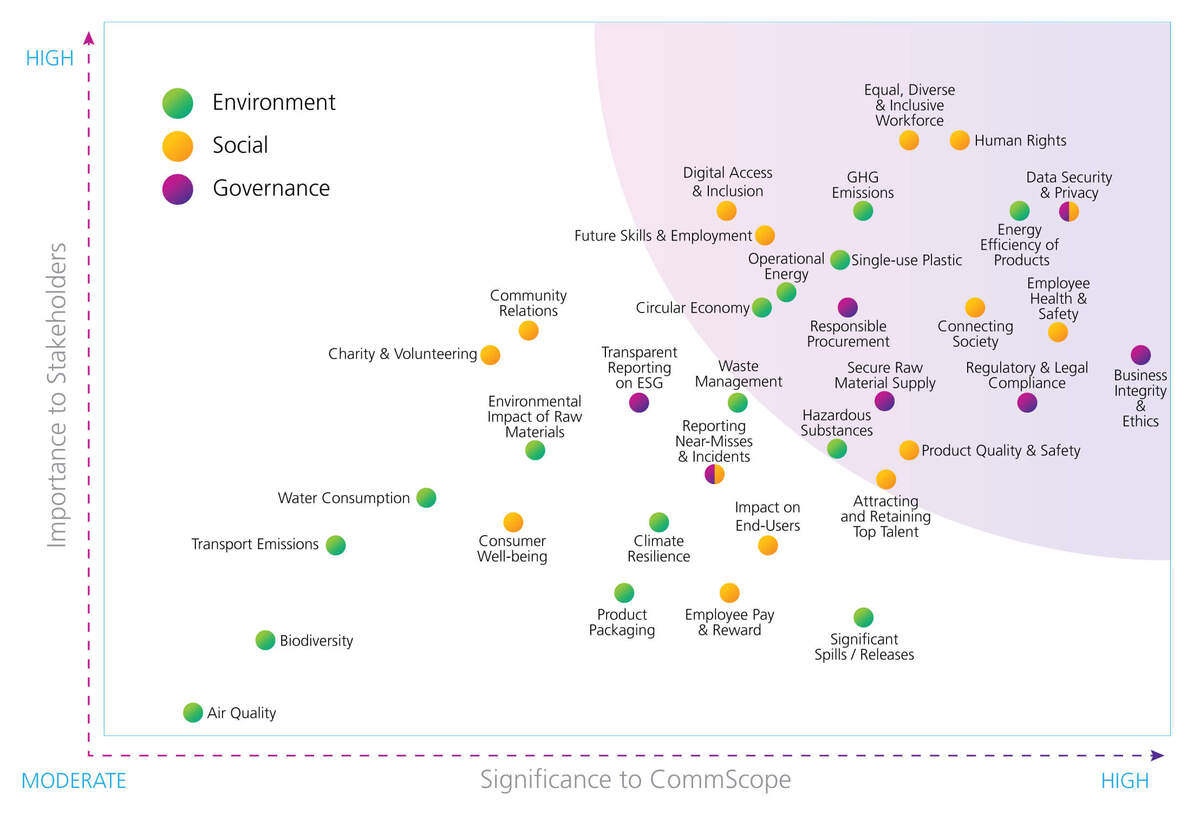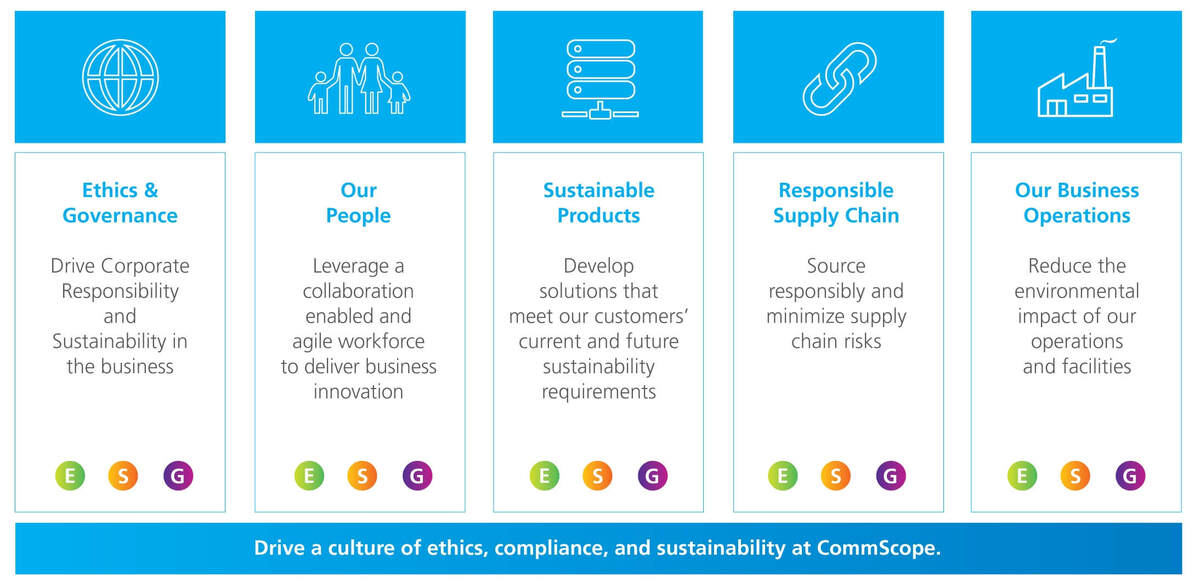Philosophy
Future focused, results driven, and on your side
Corporate responsibility is a philosophy that embraces our core company values and ensures we produce smart solutions that respect our people and our planet. This philosophy finds form in three key pillars:
- Environmental: We value the world in which we live—and continually work to minimize the environmental impact of our operations and products.
- Social: We value the human rights of our employees and work diligently to improve the wellness and personal safety of our professionals and positively contribute to the communities near our facilities.
- Governance: We value integrity and transparency—and work diligently to maintain the highest standards of ethical business practice.
Progress
At CommScope, we periodically review the sustainability issues we face and capture input from our stakeholders to identify risks and opportunities, shape our strategy and clarify where to focus our resources. We consider a wide range of economic, environmental, social and governance topics. We set short-term and long-term goals related to several of our most relevant and material topics/aspects/issues and identified key performance indicators (KPIs) to manage performance and track progress.
Materiality Assessment, Strategic Priorities, Goals
The topics in the top-right quadrant of the materiality matrix were ranked highest in importance for both our stakeholders and our business success. This was based on qualitative and quantitative data from the materiality assessment. As a result, we have focused our CR&S strategy around these key material issues. This addresses our most significant impacts, while also aligning with the needs of our customers and stakeholders. The topics below the materiality threshold are not covered in as much detail but remain important to CommScope.
The identified ESG material topics were summarized in five material topic groups. Which we then used to outline our new CR&S strategy, strategic priorities and objectives and targets.
2025 Objectives and Targets
|
Priority |
Goal |
2025 objective/target is to: |
|
Ethics and |
Drive corporate responsibility |
|
|
Our Business |
Reduce the environmental |
|
|
Sustainable |
Develop solutions that meet our customers’ current and future sustainability requirements |
|
|
Responsible |
Source responsibly and |
|
|
Our People |
Leverage a collaborative, |
|
Metrics, Key Performance Indicators
Economic performance
| Direct economic value generated and distributed | 2024 Net Revenue
|
$5.47B $2.82B $1.27B $0.55B $0.83B |
| For further insight, view our 2024 Annual Report. | ||
CommScope completed divestiture of Outdoor Wireless Networks (OWN) and Distribution Antenna Systems (DAS) business to Amphenol Corporation on February 3, 2025. Learn more here.
Environmental performance
Energy
CommScope achieved significant reduction in energy consumption in 2024 – a 13.4% reduction year over year driven largely by reduced production output and facility portfolio changes. Compared to our 2019 base year, we reduced energy consumption by 30.7%. 10.3% of purchased electricity originated from renewable sources in 2024.
| Energy consumption within the organization – total fuel consumption from non-renewable sources |
2024 Total Fuel
|
79,791 MWh 42,676 MWh |
| Energy consumption within the organization – total fuel consumption from renewable sources | 2024 Total Fuel | 0 MWh |
| Energy consumption within the organization – total electricity, heating, cooling and steam from non-renewable and renewable sources | 2024 Total Electricity and Heating
|
228,081 MWh 204,730 MWh 23,351 MWh |
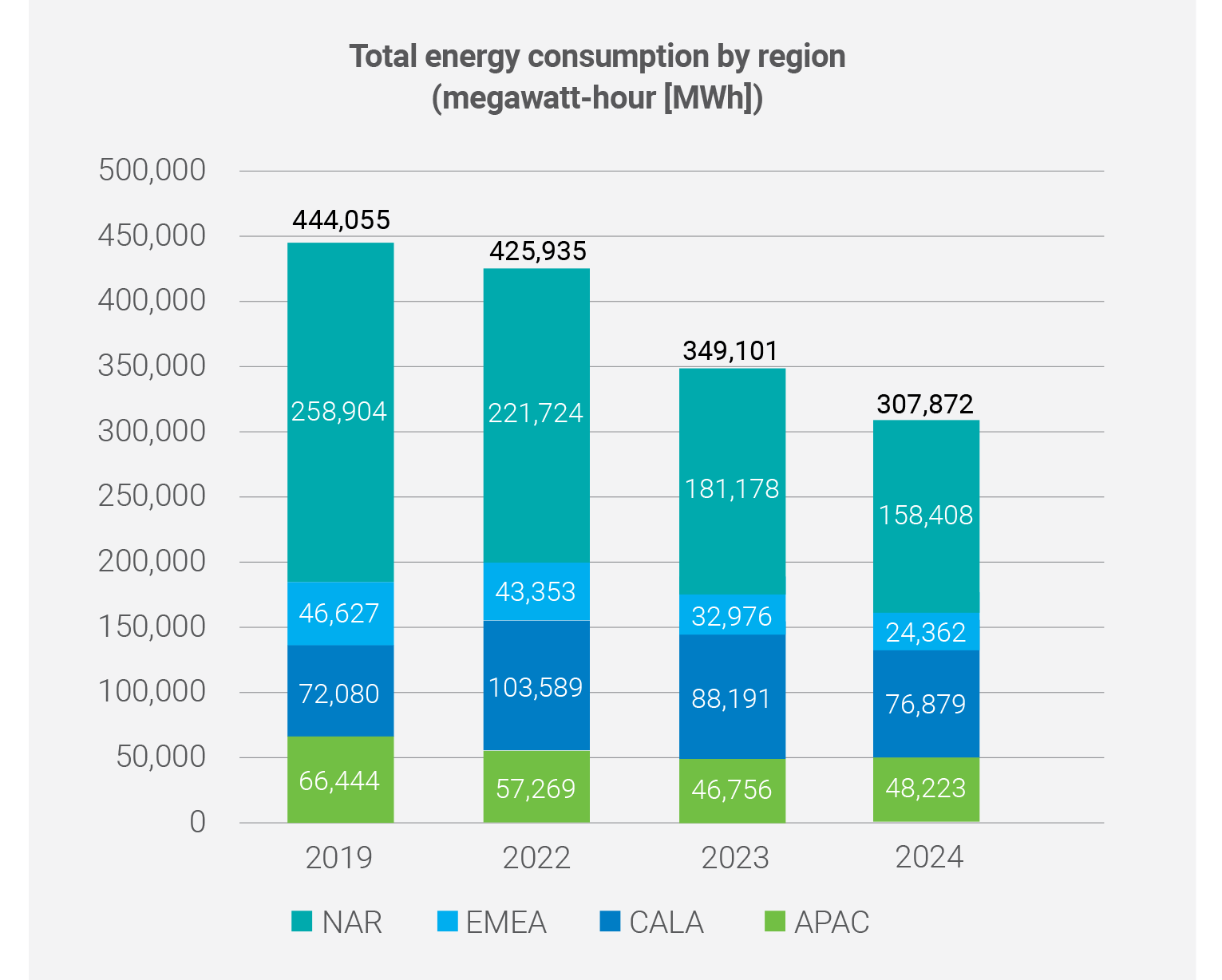
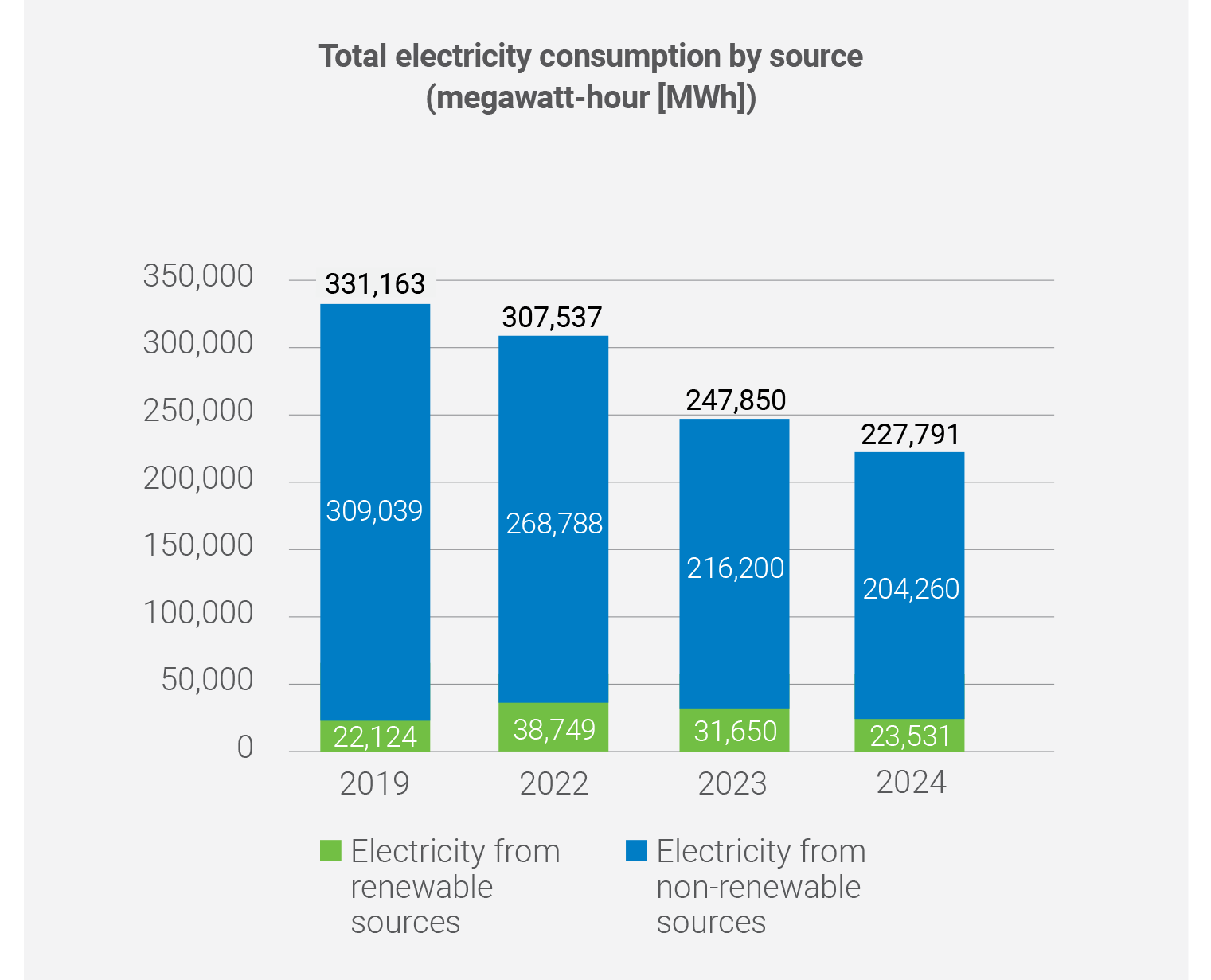
Climate change and greenhouse gas (GHG) emissions
2024 target:
- Reduce our Scope 1 and 2 greenhouse gas (GHG) emissions by at least 2% by year-end 2024 measured against our 2019 base year. [absolute GHG emissions target]
- Reduce GHG emissions across our operations through analysis and adoption of externally approved science based GHG reduction targets (Scope 1, 2 and 3).
CommScope:
- Achieved a 41.2% reduction in Scope 1+2 location-based GHG emissions compared to our 2019 base year.
- Achieved a 44.1% reduction in Scope 1+2 market-based GHG emissions compared to our 2019 base year.
- Achieved a 44.2% reduction in Scope 3 GHG emissions compared to our 2019 base year.
- Achieved a 27.5% reduction in Scope 1+2 market-based GHG emissions’ intensity, normalized per head count and compared to our 2019 base year.
- Purchased 10.3% of electricity originating from renewable sources in 2024.
- Is working towards developing long-term GHG emissions reduction targets following Science Based Targets initiative (SBTi) approach.
- Submitted a commitment letter to Science Based Targets initiative (SBTi) in June 2024.
In 2024, our Scope 1 (direct) GHG accounted for 1.5% of our total carbon footprint. Our Scope 2 (indirect) market-based GHG emissions, from the purchased electricity and heat, accounted for 3.2% of our total carbon footprint. Our Scope 3 (indirect) GHG emissions sources accounted for 95.3% of our total carbon footprint and include the following relevant categories as defined by the GHG Protocol:
- upstream activities: purchased goods and services, capital goods, fuel and energy related activities, upstream transportation and distribution, waste generated in operations, business travel, employee commuting, upstream leased assets
- downstream activities: downstream transportation and distribution, use of sold products, end-of-life treatment of sold products, downstream leased assets, investments
|
2019 |
2024 |
|
| Direct (Scope 1) GHG emissions | 72,675 m.t. CO2e | 38,175 m.t. CO2e |
| Energy indirect (Scope 2) GHG emissions market-based |
138,239 m.t. CO2e | 76,808 m.t. CO2e |
| Other indirect (Scope 3) GHG emissions | 4,250,493 m.t. CO2e | 2,372,245 m.t. CO2e |
| TOTAL | 4,461,406 m.t. CO2e | 2,490,228 m.t. CO2e |
Due to the divestiture of the Home Networks business in January 2024, our Scope 3 GHG emissions decreased significantly. This event reached our 5% materiality threshold that triggered the Scope 3 recalculation process of our base year.
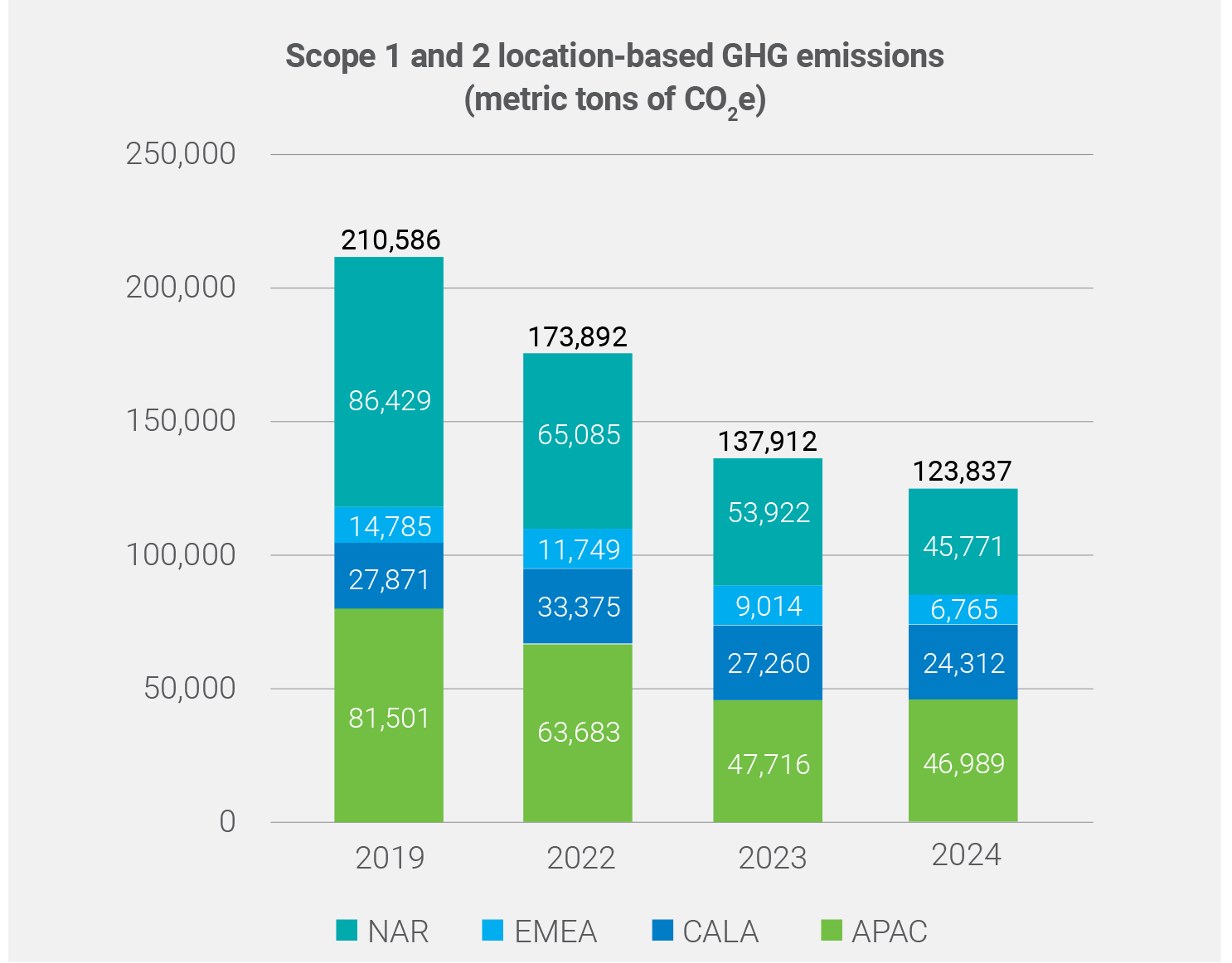
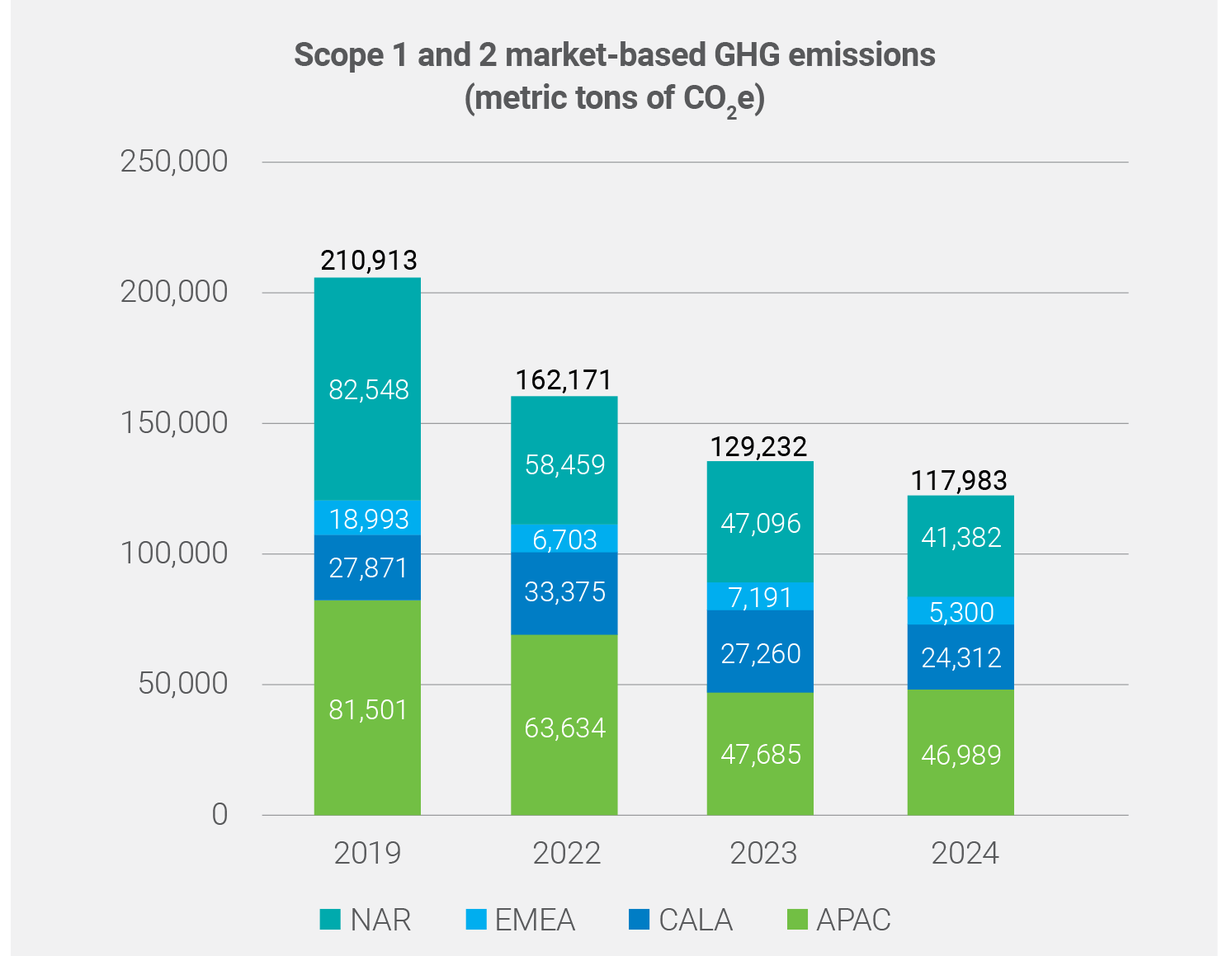
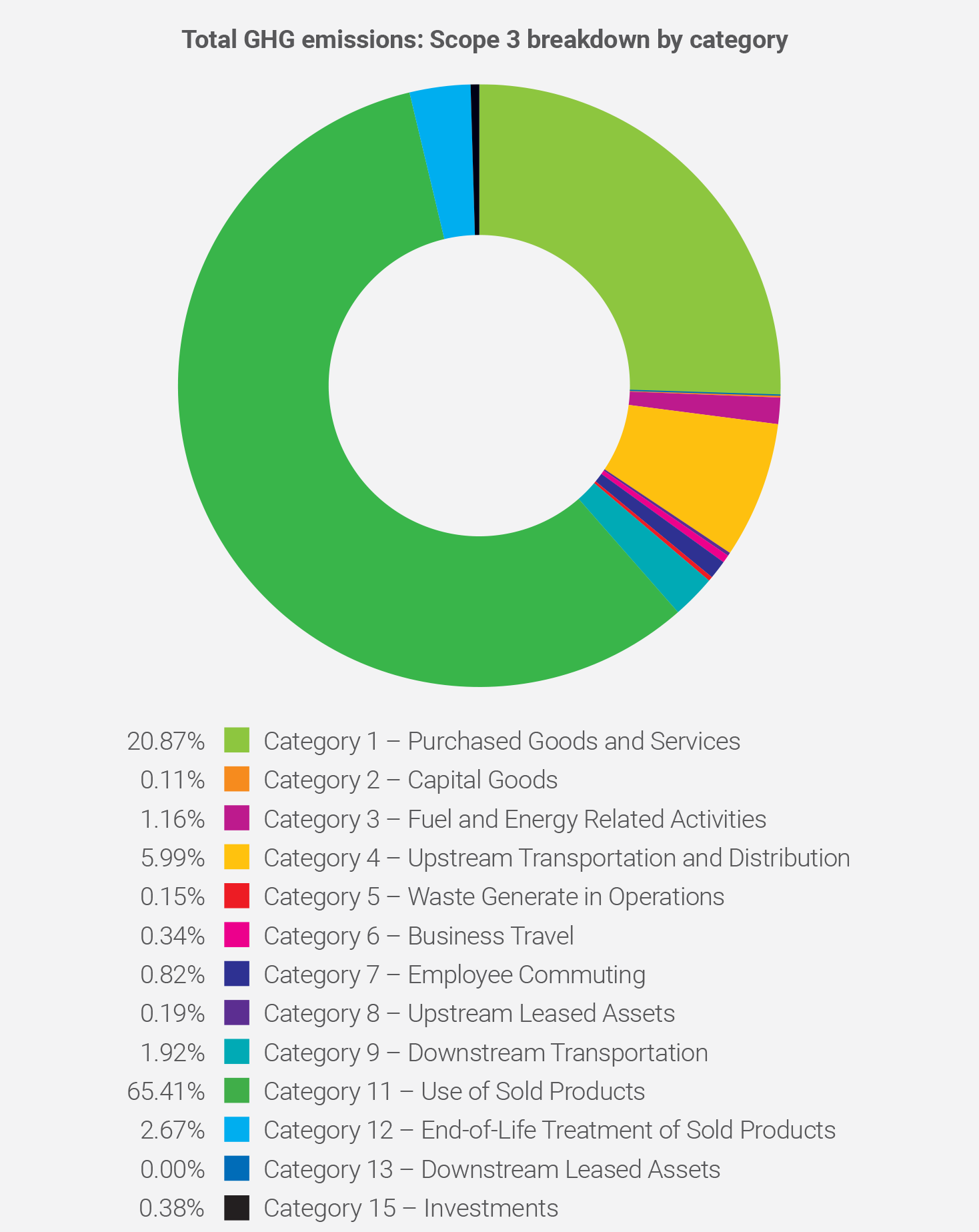
Water Management
2024 target: At minimum, maintain 2023 water usage performance normalized by total hours worked.
CommScope:
- Achieved our target and improved our water withdrawal normalized by total working hours worked by 2%.
- Increased water consumption per employee by 11% against our 2019 base year and by 7% compared to 2023.
- Achieved a 12.4% reduction in water withdrawal compared to our 2019 base year and increased by 0.1% compared to 2023.
| Total water withdrawal |
By region
|
564,983 m3 63,342 m3 193,709 m3 282,713 m3 25,220 m3 |
| By source 2024 Total
|
564,983 m3 64,306 m3 500,677 m3 |
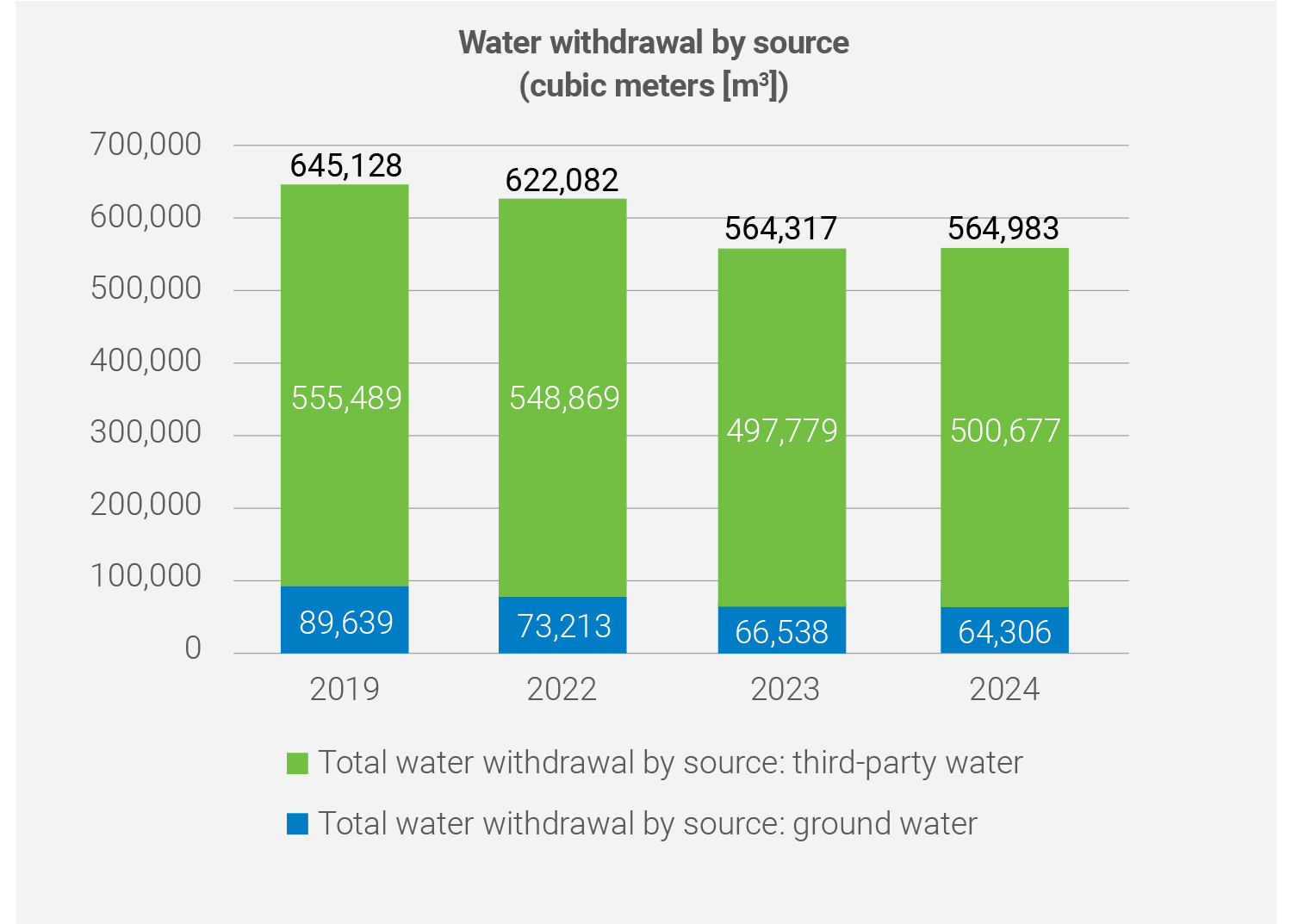
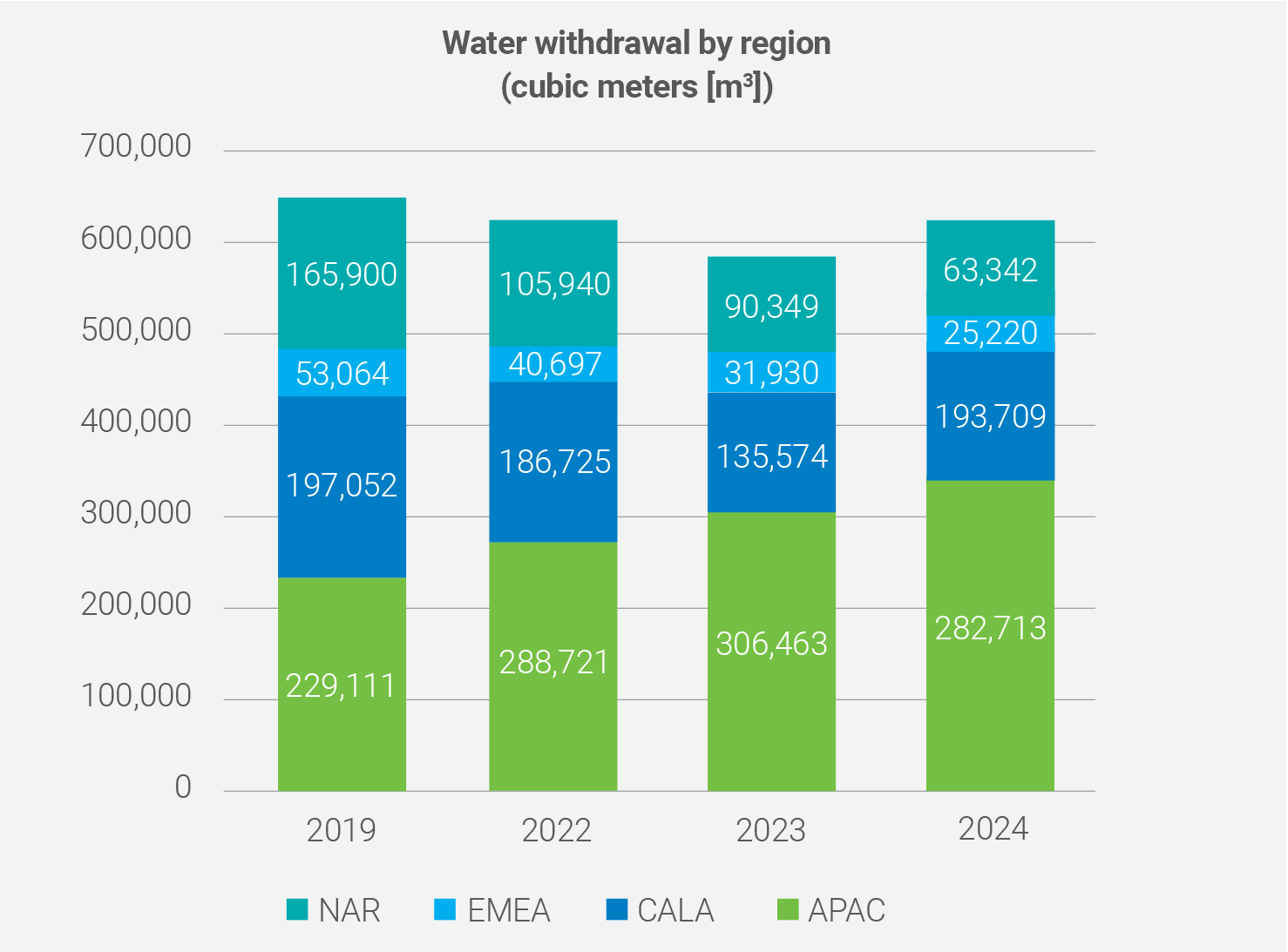
| Total number and volume of significant spills |
There were no significant spills or releases recorded at CommScope facilities in 2024. |
| CommScope EHS Management System definitions Significant spill and/or release: A significant spill or release is defined as an accidental release of any regulated or hazardous substance, physical or biological agent that may affect human health, land, vegetation or bodies of water. If the significant spill or accidental release impacts the air, water or land outside a facility and requires a designated EHS person to report the matter to any jurisdiction—or requires a third party for cleanup—it must be reported. |
Waste Management
2024 target:
- Achieve a 2% increase in waste recycled/reused/eliminated over 2023 volumes.
CommScope:
- Didn’t achieve the target due to reduced production levels in 2024 which impacted the volumes of waste that could be recycled, reused or eliminated. Our increased fiber-optic cable production also contributed to this shortfall.
- Generated 21% less operational waste compared to 2023.
- Diverted 81.8% of nonhazardous waste and e-waste from landfills in 2024.
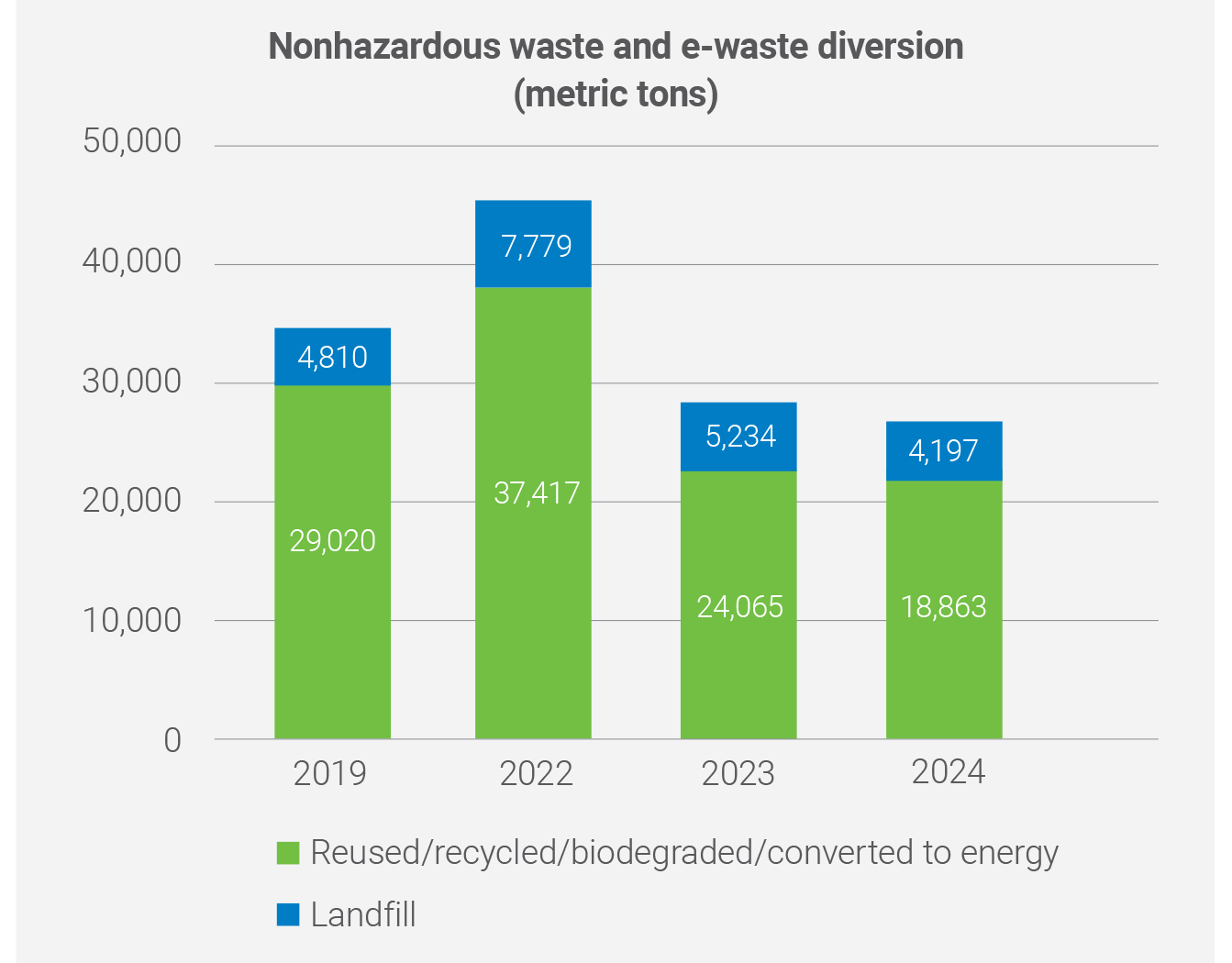
Social performance—labor practices and decent work, human rights
Total workforce by employment type, employment contract and region
| Total workforce by employment type, employment contract, and region | More than 25,000 employees in 2024 |
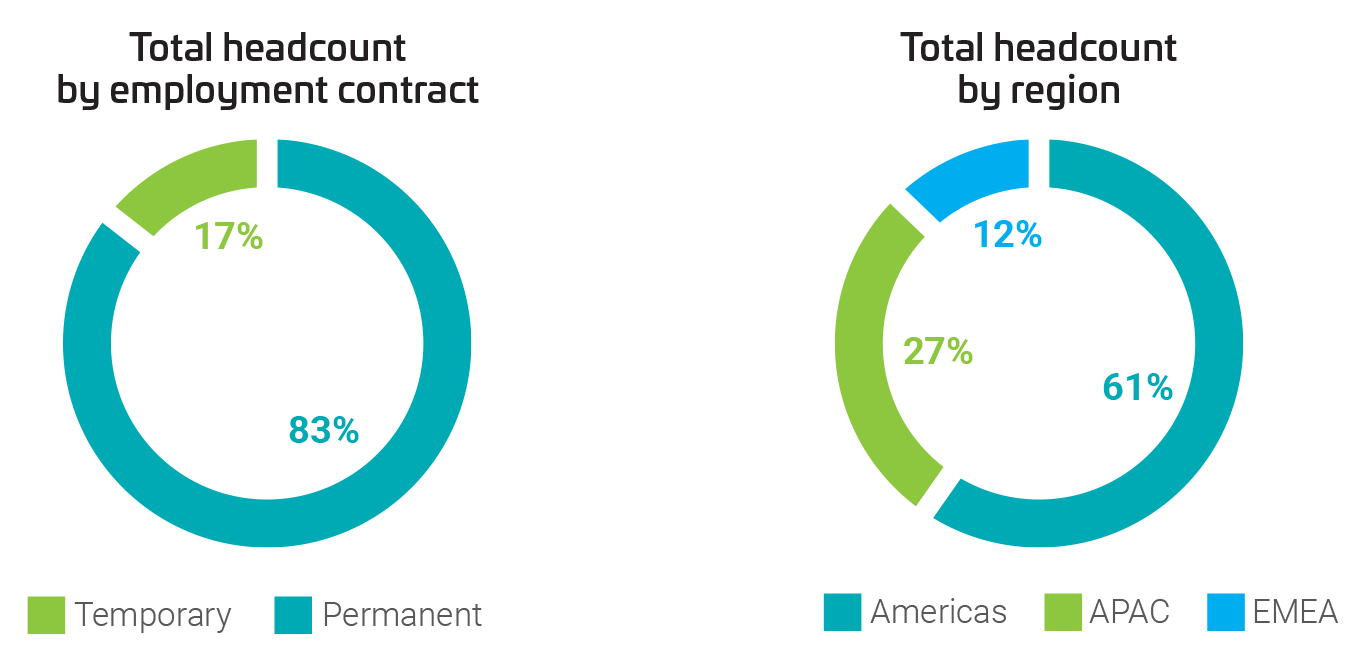
Global statistics by employment contract reflect the nature of employment relationship in the countries where we operate.
Employee data
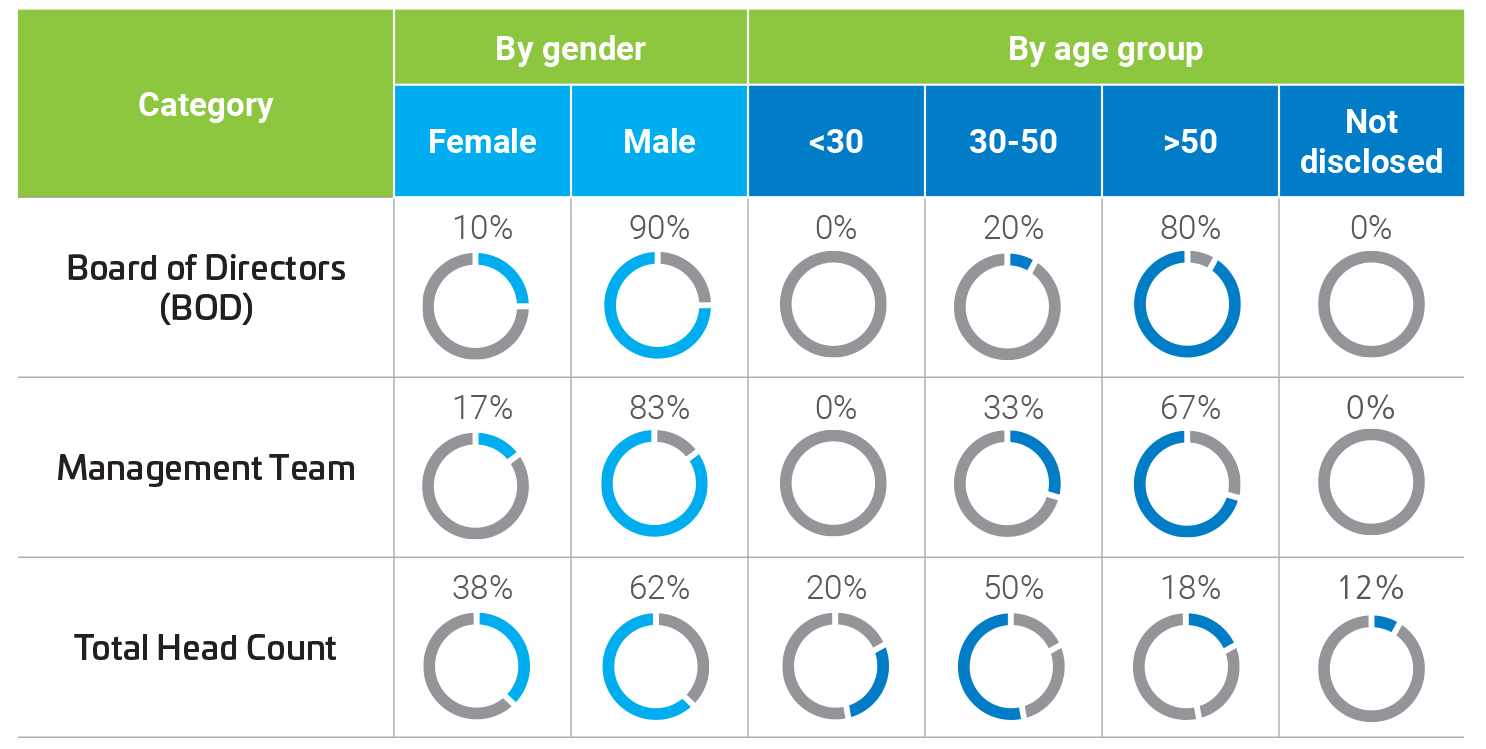
* Employee diversity by age is tracked for CommScope’s permanent/regular employees and internal temporary employees. In mid-2023, CommScope moved to a new tool (Employee Central) which only tracks information for employees with direct employment relationship with CommScope. Other tools/applications are used by various regions/countries for managing information about external temporary employees, these don’t include age tracking only a confirmation that workers are above the legal minimum age.
Rates of injury, lost and restricted days
In 2024 CommScope achieved a global injury rate of 0.24, 73.3% below the U.S. OSHA industry rate of 0.9.
| Rates of injury, occupational diseases, lost days, and number of work-related fatalities. | 2024 Injury rate | 0.24 |
| Lost and restricted (days away) rate | 7.47 | |
| 2024 Work-related fatalities | Zero |
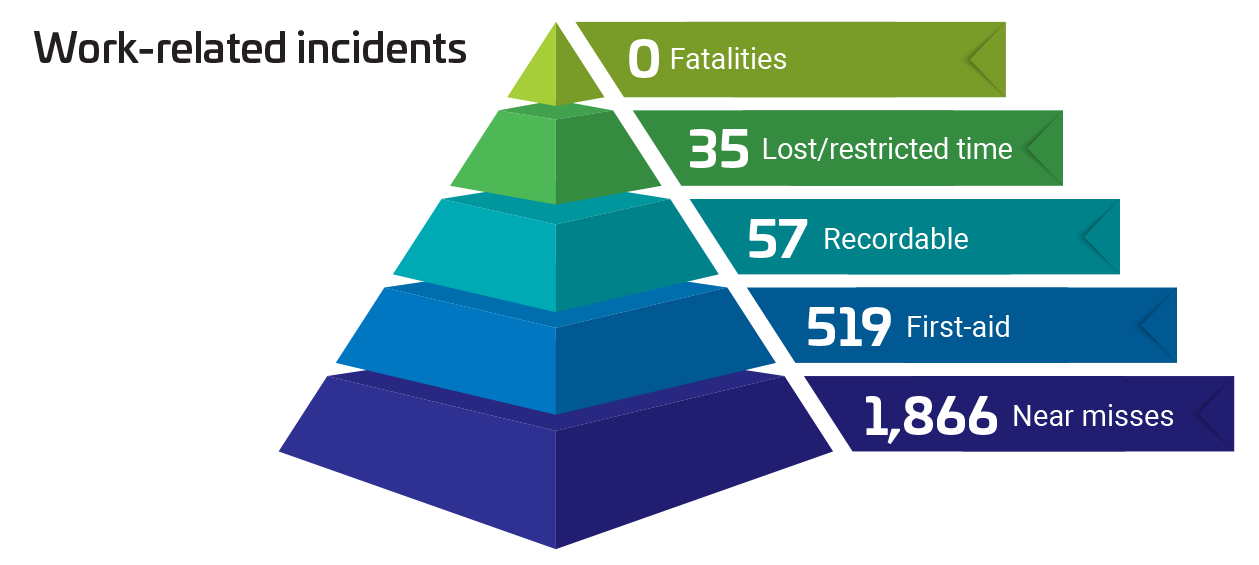
Note 1: Injury rate was calculated based on 200,000 hours worked.
Note 2: Injury rate calculation includes fatalities as a result of work-related injury, high-consequence work-related injuries, and recordable work-related injuries.
CommScope EHS Management System definitions
Incident
An unplanned event which has had an impact and the severity of that impact is such that an evaluation is required to determine if the event shall be dealt with using internal resources, external resources and/or the ‘Corporate Crisis Management Team’.
First Aid Incident
Incident where the only treatment required by the injured person is first aid or less.
Recordable Incident
Incident that the injury/illness requires more than first aid treatment. The treatment may begin with first aid but then goes onto more advanced care.
Lost Time Incident
Incident that most likely requires more than first aid and includes:
• At-work Restricted Work Day(s),
• Days Away / Lost Work Day(s),
• Injuries/Illness resulting in job transfer duties.
Fatality
Death due to work related incident.
Lost Work Day(s)
Any days that an employee is unable to work because of a work-place injury. Lost Work Days are counted on the calendar year, which also includes weekends, holidays, company shut-downs etc., regardless if the employee is required to work any of these days. Subsequent days after the injury date qualify as lost time injury cases.
Restricted Work Day(s)
Restricted duty is often referred to as “modified duty” and is defined as: any modification to an employee’s job duties that he or she normally performs at least once a week, or employee inability to work a full shift (restrictions require a physician order). Restricted Work Days are counted on the calendar year, which also includes weekends, holidays, company shut-downs etc., regardless if the employee is required to work any of these days. Subsequent days after the injury date qualify as restricted/lost time injury cases.
Child labor, forced labor
Operations and significant suppliers considered to have significant risk for incidents of child labor, including measures taken to contribute to the effective abolition of child labor.
| Operations with significant risk in 2024 | Goa, India Delicias, Mexico Juarez-Bermudez, Mexico Juarez-Praderas, Mexico Reynosa, Mexico Tijuana, Mexico Suzhou (CSA), China Suzhou (CSC), China |
| Suppliers with significant risk in 2023 [by countries] |
Americas:
|
| Control measures | Company policies
Internal audits — manufacturing facilities Employee Engagement, Training and Development Communication
|
New and existing suppliers assessed in 2024:
| Existing suppliers | New suppliers | Total | |
| Americas | 45 | 9 | 54 |
| Asia-Pacific | 114 | 17 | 131 |
| Europe, Middle East, Africa | 15 | 2 | 17 |
| Total | 174 | 28 | 202 |
In 2024, we screened 202 suppliers, including 100% of new suppliers. Supplier screening includes environmental and social criteria. After completing the 2024 audit process, a total of 4% of suppliers were identified as high risk. For active high-risk suppliers, we planned 2025 follow-up audits. Measures we took in the reporting period were intended to help eliminate all forms of child, forced or compulsory labor. There were no reported incidents of forced labor, child labor, slavery or human trafficking found.
Supplier audits/on-site assessments
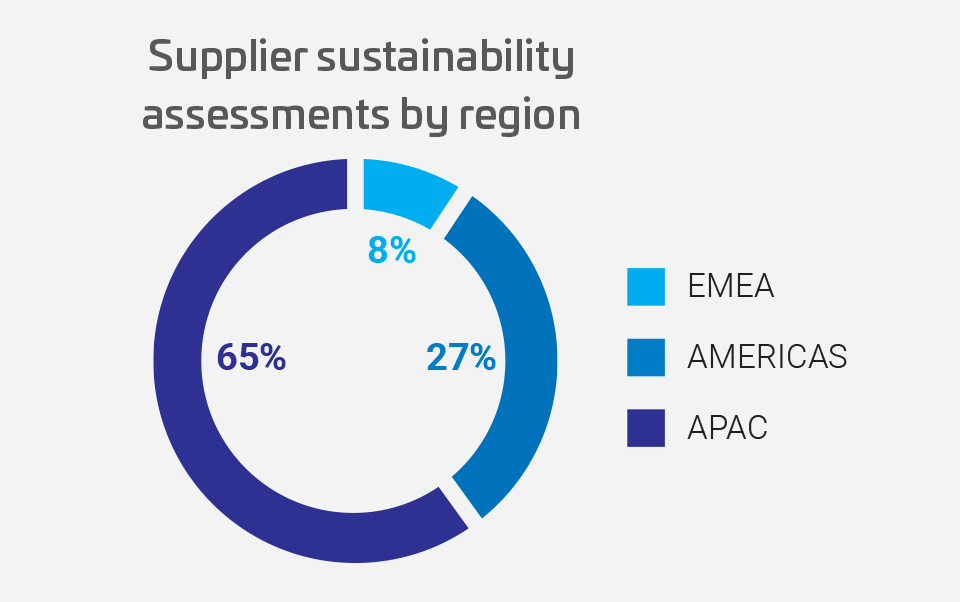
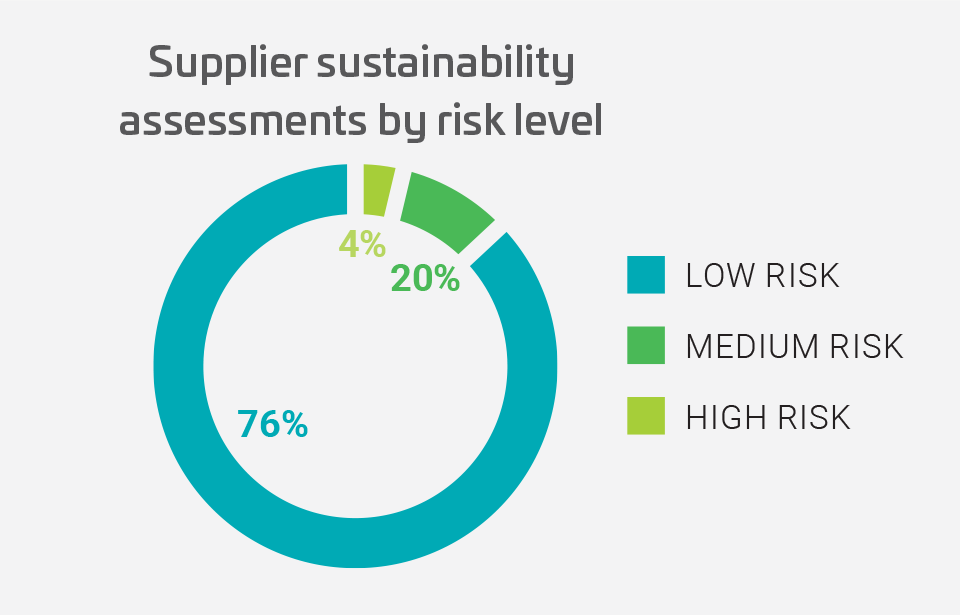
Ethics
Significant Risk Identification and Non-compliance
Each quarter in 2024, CommScope conducted outreach across all business segments to evaluate any potential ethical risk, including corruption. This quarterly outreach included on average 2,000 employees receiving the Period Executive Disclosure Questionnaire (based on their job level and job function) and four Executive Leadership Team (ELT) members being interviewed. We identified no significant risks or incidents regarding corruption.
Separately, CommScope didn’t identify any significant noncompliance with environmental, social and economic laws and/or regulations in 2024.
CommScope received no administrative complaints regarding privacy or data protection in 2024.
Recognizing excellence
We celebrate our company’s recognitions from a variety of respected organizations and publications. View the list of award-winning CommScope professionals and solutions in our Sustainability Reports and Infographics.
Recognizing excellence
We celebrate our company’s recognitions from a variety of respected organizations and publications. View the list of award-winning CommScope professionals and solutions in our Sustainability Reports and Infographics.
Reporting
CommScope’s annual sustainability report (following the Global Reporting Initiative (GRI) Standards and guidelines) provides information about our economic, environmental, and/or social impacts—positive or negative—toward the sustainable development goals. The report details our efforts to protect the environment, promote the health and safety of our workforce, and support the communities where we operate. You can find recent reports here.
Risk Assessment
CommScope proactively manages risk. We recently completed a corporate-level assessment using the EcoVadis platform. CommScope was awarded gold-level recognition and achieved an overall scope of 77/100, which certifies:
- Our structured, proactive approach to corporate responsibility
- Our established policies and processes to help tackle important issues
- Our capacity to clearly report on selected activities and key performance indicators
Our manufacturing facilities utilize the RBA Online self-assessment questionnaire to identify risks and opportunities for improvement. We also use Entropy, our primary EHS risk assessment/management tool, to perform a variety of internal monitoring and reporting activities.
Internal Audits
CommScope routinely audits our manufacturing facilities using ISO14001, ISO45001, SA8000 and ISO26000 standards to ensure compliance to the environment, health, safety, labor and ethical business practices. Facilities in high-risk countries are audited for labor and ethical practices by our CoRe team every two years, while facilities in low-risk countries are audited every three years. Our EHS team audits environment, health and safety practices every three years using international and company standards. Each externally certified facility also maintains its own team of internal auditors.
Reporting to the Audit Committee of CommScope’s Board of Directors, our Corporate Audit and Advisory team also performs independent, objective audits of our internal processes and controls following the Institute of Internal Auditors International Professional Practices Framework.
Certifications
CommScope maintains a variety of certifications based on four widely accepted industry standards.
To view a specific certification, select your preferred facility location:
Quality Management System certifications (ISO9001/TL9000):
TL9000 Multisite (TL151045.000)
Apodaca, Mexico | Catawba, NC, U.S. | Claremont, NC, U.S. | Delicias, Mexico | Goa, India | Juarez-Bermudez, Mexico | Juarez-Praderas, Mexico | Reynosa, Mexico | Suzhou, PRC | Tijuana, Mexico
ISO9001 Multisite (ISO111045.000)
Bangalore (ADC), India | Bodelwyddan, U.K. | Bray, Ireland | Brno, Czech Republic | Buenos Aires, Argentina | Claremont, NC, U.S. | Suzhou, PRC | Tijuana, Mexico
Health and Safety Management System certifications (ISO45001):
Multisite | Bray, Ireland | Brno, Czech Republic | Buchdorf, Germany | Catawba, NC, U.S. | Claremont, NC, U.S. | Delicias, Mexico | Euless, TX, U.S. | Goa, India | Juarez-Bermudez, Mexico | Juarez-Praderas, Mexico | Malton, U.K. | Reynosa, Mexico | Rhyl, U.K. | Suzhou (CSA), PRC | Suzhou (CSC), PRC | Tijuana, Mexico | Warrington, U.K.
Environmental Management System certifications (ISO14001):
Multisite | Bray, Ireland | Brno, Czech Republic | Burchdorf, Germany | Catawba, NC, U.S. | Claremont, NC, U.S. | Delicias, Mexico | Euless, TX, U.S. | Goa, India | Juarez-Bermudez, Mexico | Juarez-Praderas, Mexico | Malton, U.K. | Reynosa, Mexico | Rhyl, U.K. | Suzhou (CSC), PRC | Suzhou (CSA), PRC | Tijuana, Mexico | Warrington, U.K.

